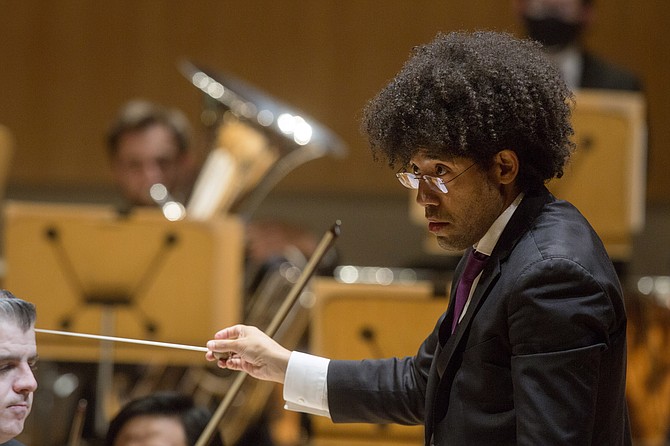 Facebook
Facebook
 X
X
 Instagram
Instagram
 TikTok
TikTok
 Youtube
Youtube

When Rafael Payare conducts the San Diego Symphony it’s not a concert, it’s an event. Such was the case on Saturday, October 8, at The California Center for the Arts Escondido.
The first virtues of this concert were its indoor setting and the feeling of return to what felt like a normal concert atmosphere. There were no overwrought security measures. There were no mask requirements for the audience (although the orchestra was masked), and there wasn’t a proof of vaccination requirement. It felt like October of 2019, and it felt good. The CDC has declared that the pandemic is over, so hopefully this will be the status quo from now on.
The concert opened with the overture from Der Freischütz by Carl Maria von Weber. Weber often gets lost in the Beethovian shadow; he was born 16 years after Beethoven, but died a year before Beethoven did. To my mind, Weber’s music has always felt as though he composed in the generation after Beethoven, leading directly into Richard Wagner, but this is not the case.
The performance was carefully executed, yet exciting. The tuning of the opening chorale section was so precise that it created a sonority beyond the sum of the individual notes. I’m not sure that effect would have come across in an outdoor setting. The conclusion of the overture blasted off with a massive tutti chord by the orchestra. As always, Payare kept the momentum until the final notes of the piece.
Cellist extraordinaire Alisa Weilerstein then played Sergei Prokofiev’s Sinfonia Concertante for Cello. Weilerstein is a performer who understands that physical expression is an important part of the audience’s understanding and enjoyment of a piece of music. Her playing is spectacular, and is made all the more accessible by her physicality.
Whenever I hear Prokofiev’s music, I am overwhelmed by the amount of melodic genius he displays. I might tend to think of tone color or rhythm when I hear his name, but the melodic quality of his music is paramount. Nowhere was this more evident than in the exquisite second movement. Both orchestra and soloist produced gorgeous melodic phrasing throughout, but that slow movement was special.
When Payare conducts a piece of music such as Beethoven’s Symphony No. 5, which concluded the concert, I am always impressed with his scorched-earth, take-no-prisoners approach to rubato. There are no grandiose pauses or operatic fermatas. The music tumbled forward from start to finish, leaving the audience breathless and convinced that something important just happened — as indeed was the case.


When Rafael Payare conducts the San Diego Symphony it’s not a concert, it’s an event. Such was the case on Saturday, October 8, at The California Center for the Arts Escondido.
The first virtues of this concert were its indoor setting and the feeling of return to what felt like a normal concert atmosphere. There were no overwrought security measures. There were no mask requirements for the audience (although the orchestra was masked), and there wasn’t a proof of vaccination requirement. It felt like October of 2019, and it felt good. The CDC has declared that the pandemic is over, so hopefully this will be the status quo from now on.
The concert opened with the overture from Der Freischütz by Carl Maria von Weber. Weber often gets lost in the Beethovian shadow; he was born 16 years after Beethoven, but died a year before Beethoven did. To my mind, Weber’s music has always felt as though he composed in the generation after Beethoven, leading directly into Richard Wagner, but this is not the case.
The performance was carefully executed, yet exciting. The tuning of the opening chorale section was so precise that it created a sonority beyond the sum of the individual notes. I’m not sure that effect would have come across in an outdoor setting. The conclusion of the overture blasted off with a massive tutti chord by the orchestra. As always, Payare kept the momentum until the final notes of the piece.
Cellist extraordinaire Alisa Weilerstein then played Sergei Prokofiev’s Sinfonia Concertante for Cello. Weilerstein is a performer who understands that physical expression is an important part of the audience’s understanding and enjoyment of a piece of music. Her playing is spectacular, and is made all the more accessible by her physicality.
Whenever I hear Prokofiev’s music, I am overwhelmed by the amount of melodic genius he displays. I might tend to think of tone color or rhythm when I hear his name, but the melodic quality of his music is paramount. Nowhere was this more evident than in the exquisite second movement. Both orchestra and soloist produced gorgeous melodic phrasing throughout, but that slow movement was special.
When Payare conducts a piece of music such as Beethoven’s Symphony No. 5, which concluded the concert, I am always impressed with his scorched-earth, take-no-prisoners approach to rubato. There are no grandiose pauses or operatic fermatas. The music tumbled forward from start to finish, leaving the audience breathless and convinced that something important just happened — as indeed was the case.
Comments